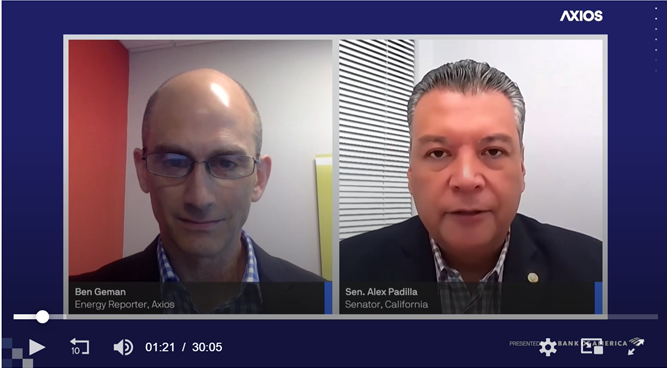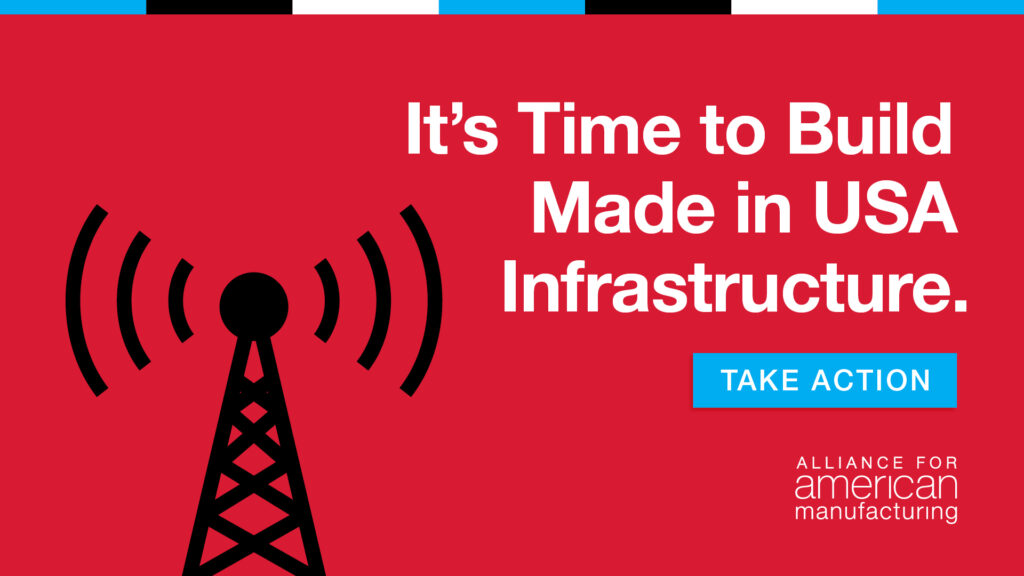
Sen. Alex Padilla (D-Calif.) joined Axios for a conversation on “powering up clean energy jobs” on Friday. Jason Walsh of the BlueGreen Alliance also took part, arguing that “we don’t have to choose between good jobs and a good environment.”
We’ve heard politicians and activists alike wax poetically of America’s clean energy potential; of transforming the United States’ great economic might into that of a green giant with good, high-paying, union jobs. But how do we get there?
On Friday, Axios sat down (or opened up a Zoom window) with Sen. Alex Padilla (D-Calif.) and Jason Walsh, executive director of the BlueGreen Alliance, to examine the potential future of America’s clean energy infrastructure.
Padilla spoke first, giving viewers a front-row look into the ongoing budget reconciliation negotiations that will begin to lay the groundwork for taking on climate change. While Padilla lauded the Senate’s passage of the $1.2 trillion infrastructure investment legislation, he warned that “[the bill is] significant, but nowhere near enough.”
“We have to go big in our investments in infrastructure, and if you’re not convinced that we need to tackle climate with urgency, look what’s happened in recent weeks,” he said, pointing to the damage caused across the country from Hurricane Ida and raging wildfires in his home state of California.
“That should be all the evidence we need to go big on climate, and we have such a unique opportunity at this time.”
Out of crisis does come opportunity, including the chance to work across party lines, Padilla noted. The California Democrat recently partnered with Texas Sen. John Cornyn (R) on legislation to invest in the resiliency of the electrical grid after winter storms left the Lone Star State without power for several days. That measure proved so popular that it was absorbed into the larger infrastructure bill and “they multiplied the amount of money we were asking for by five,” Padilla said.
“For better and for worse, sometimes it does take natural disasters like this to change the politics and the discourse a little bit,” he said.
Padilla highlighted his time in the California state legislature as a potential blueprint for additional ways to maximize action on climate, including by retraining workers and training younger workers, introducing new industry, and a climate conservation corps, taking its namesake from the infamous New Deal Civilian Conservation Corps (CCC). Initiatives like these can also help address “economic justice issues because some folks that have been shut out of these investments in the past.”
Padilla also pointed to a clean energy tax credit, clean tech accelerator, and a manufacturing tax incentive as other, substantial means to bring clean energy infrastructure to the United States. “We don’t just want to invest in renewable energy sources, but try to bring a lot of the investment and job creation opportunity here,” Padilla said.
Padilla said he hopes that both the $1.2 trillion bipartisan infrastructure framework, and the larger, $3.5 tirllion human infrastructure package through budget reconciliation, is complete before the next UN Climate Summit.
“It would be a huge boost to President Biden and the administration’s efforts to bring the world along,” Padilla said. “He can talk the talk… but it’s always so much more impactful to show what we’re doing in the United States… we can demonstrate to our partners globally that we can walk the walk.”
Walsh, whose organization is a coalition of labor unions and environmental organizations, seconded Padilla’s conclusions.
“We don’t have to choose between good jobs and a good environment: we have to have both,” he asserted, noting, “I think as a country we have learned, or re-learned, just how many workers are working paycheck to paycheck… we have the ability with budget reconciliation to address these crises that are as mutually reinforcing and intersecting as their causes. And we feel like we can’t afford not to take advantage of this opportunity.”
Specifically, Walsh looked to turn the conversation from the abstract into the practical. “In the power sector alone, we’re going to have to quadrupole clean energy levels of deployment every year for the next 10 years to meet our climate goals. We’re steering toward net carbon neutral by 2050,” Walsh said.
Walsh believes that with the pending passage of both infrastructure packages, 600,000 new jobs could be created by just the power sector, if done right — and even he admits it’s a big “if”.
But Walsh said we know what to avoid in pursuing America’s climate priorities.
“From the perspective of our coalition, the big challenges in doing that successfully… are threefold,” he said. “One are ensuring the jobs are high quality, accessible, and across the whole value chain including in manufacturing. Two, targeting investment and the jobs it creates to communities in parts of the country that need it the most… and three, ensuring that the workers and communities that have relied on fossil energy and that have powered this country for generations are not left behind as we make this transition. To date, we don’t think we’ve met these challenges particularly well.”
But now there’s a chance to do things right, and Walsh is optimistic. “We think we can get it done,” he said.
Click here to watch the entire Axios event.

